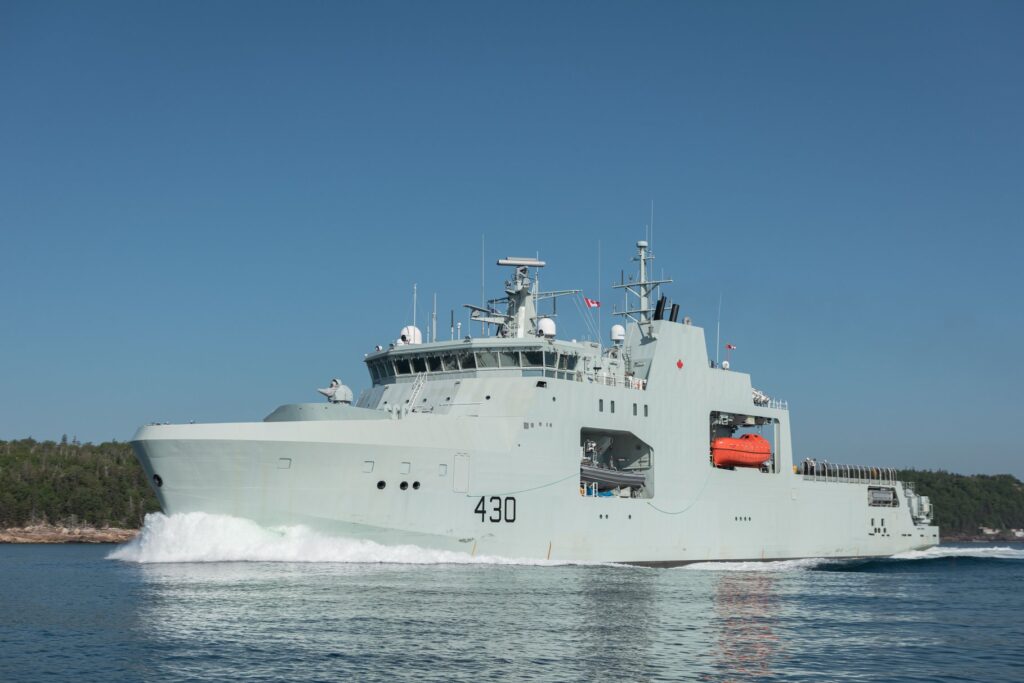
The Royal Canadian Navy Arctic and offshore patrol ship HMCS Harry DeWolf (AOPV 430) recently called at Naval Station Norfolk, Virginia, as the final stop on its historic circumnavigation of North America.
Commissioned in June, Harry DeWolf is the Royal Canadian Navy’s first new warship in 25 years and its first ice-capable vessel since HMCS Labrador in 1958.
For its first voyage, Harry DeWolf transited to the Arctic to participate in Canada’s Operation Nanook annual training exercises in the high north, then continued through the Northwest Passage and working with the U.S. Coast Guard in Alaskan waters. From there the patrol vessel proceeded to San Diego and embarked a U.S. Coast Guard law enforcement detachment and conducted counter-narcotics operations in the Eastern Pacific and the Caribbean Basin.
In Alaska, the ship participated in a mass casualty drill with the U.S. Coast Guard. Further south, the crew took part in Op Caribbe, Canada’s contribution to U.S. enhanced counter-narcotics operations under U.S. Joint Interagency Task Force South in the Eastern Pacific and Caribbean. Working with an embarked U.S. Coast Guard Law Enforcement Detachment, Harry DeWolf helped with the seizure and offload of approximately 26,250 pounds of cocaine and 3,700 pounds of marijuana worth about $504 million from the USCGC Hamilton (WMSL 753) in Port Everglades, Florida, Nov. 22.
The ship arrived in Norfolk Dec. 9 and departed Dec. 12.
While highly capable for polar operations, the ship is also designed to conduct patrols wherever needed in the world. HMCS Harry DeWolf Commanding Officer Cmdr. Corey Gleason said the unique ship design is specific to Canadian needs.
“Our allies all have offshore patrol vessels, but they don’t have the Arctic stamp on it. If we are truly going to operate our domestic waters, we have to be to go north, not just during the navigable between July and October, but any time. Earlier this year we were up in the dead of winter breaking ice, with no other ships,” he said.
The deployment also demonstrated the endurance of the ship as it visited ports and communities in Nunavut, Northwest Territories and Yukon Territory. While the ship did take on fuel during port visits to Nuuk, Greenland, and Dutch Harbor, Alaska, Gleason said the ship has the range to sail from Halifax to the Esquimalt naval base in British Columbia on a single tank of fuel.
“I always knew that this ship had an incredible capability anywhere in the world. And we demonstrated that tenfold in the four and a half months that were deployed,” he said.
Gleason said the Royal Canadian Navy doesn’t have a great deal of experience operating in the ice. As the skipper of the first Arctic and offshore patrol ship, Gleason said he spent a lot of time providing ship-handling experience to his officers, and he’s been training the commanding officers, executive officers and navigators of the other ships to help them get ready for the Arctic when their ships are commissioned.
During the deployment, the ship underscored the close working relationship between maritime services of Canada and the U.S.
“In terms of our cooperation, the United States is really is our premier partner in the Arctic,” said Martin Loken, deputy head of mission for foreign policy and national security at the Embassy of Canada in Washington. “Canada’s Arctic and Northern Policy Framework sets out our overall government approach to the north and to the Arctic. There are a lot of elements there, and almost every single one of them aligns with U.S. interests in the Arctic, whether it’s providing economic opportunities for populations, building and investing in stronger, more resilient infrastructure, preparing for the impacts of climate change, advancing indigenous reconciliation, and the list goes on.”
A U.S. naval officer joined the ship for its first deployment. Lt. j.g. Kyle Luchau of the guided-missile destroyer USS Winston S. Churchill (DDG 80), served as a liaison officer and completed the circumnavigation of North America.
The RCN plans to build six Arctic and offshore patrol ships at the Irving Shipyard in Halifax, which are being constructed as part of Canada’s National Shipbuilding Strategy. Two more AOPS will be built for the Canadian Coast Guard.
- A Day to Remember - September 11, 2023
- Indo-Pacific Maritime Security Exchange will examine emerging capabilities and capacity - July 12, 2023
- Cold Waters Spark Warm Relationship - April 20, 2023






